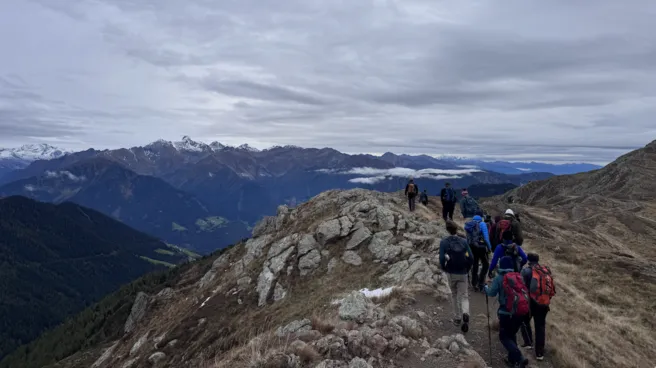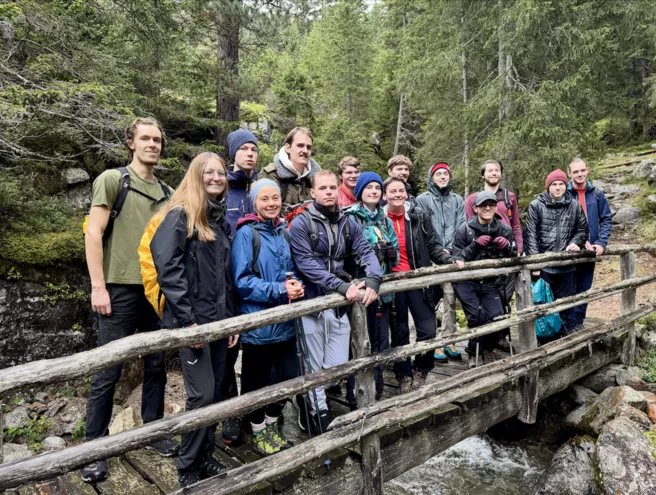This year, the Summer School (Ferienakademie) jointly organized by Technical University of Munich (TUM), the Friedrich-Alexander University of Erlangen-Nürnberg and the University of Stuttgart, took place for the 40th time. From September 22 to October 4, 2024, professors and students from all three participating universities set out for a fortnight filled with science, hiking and social interaction in the remote Sarn Valley in South Tyrol (Italy). Notably, NAT School Professors Franz Hagn, Dominik Bucher, Andreas Weiler and Stephan Schönert organized two courses combining theory and on-site experiments. Though very different in theme, each course took advantage of the unique environment, using the natural beauty and scenery of South Tyrol to address different scientific questions.
Nuclear Magnetic Resonance in Chemistry and Medicine course
Nuclear magnetic resonance (NMR) spectroscopy and magnetic resonance imaging (MRI) are of utmost importance in (bio-)chemical and medical research to obtain structural information of molecules as well as images of biological specimens. To broaden the understanding of both the scope and the limits of these techniques, and to provide some hands-on experience with these instruments, Hagn and Bucher loaded their car with a small and mobile benchtop NMR spectrometer and the necessary parts to build a teaching MRI setup, and then set off for Hotel Feldrand.
The course started with a theoretical background and an initial introduction to the equipment. Following an NMR quiz (Who can identify the chemical compound based on the measured NMR spectrum?), the students built an MRI instrument. Images of various 3D objects, including an avocado, were recorded, illustrating how scientific projects may lead to unexpected works of art.
Having come to grips with these new techniques, the twelve highly motivated students with backgrounds in chemistry, biochemistry, physics and medical technology, worked in tandem to investigate their own topics. The hiking trips interspersed throughout the course were conveniently chosen to obtain water samples from mountain springs for analysis (Do they contain iron as local people suggest?). Other projects stayed closer to the hotel, investigating painkillers like aspirin, vitamin supplements (What portion of a tablet is actually vitamin?), sunscreen, as well as various fruits and vegetables.
Dark Matter and the Cosmos course
Meanwhile, Schönert, Weiler and their students pondered a bigger question that has fascinated many for a long time: What is the history of our universe? From the Big Bang theory, via exponential expansion and cosmic rays to the present: Why do physicists believe we need dark matter to explain the present state, and what are the possible theoretical explanations behind it?
Before the start of the course, students were assigned to read The First Three Minutes: A Modern View of the Origin of the Universe (1993) by Steven Weinberg to ensure that everyone, whether a physics, mathematics, AI, air- and space travel or informatics student, would have the same basic level of understanding. This course combined both theoretical and experimental particle physics, giving a general overview of the different approaches and theories surrounding the presence and detection of dark matter, with students giving presentations about the different aspects.
Dark matter, to date, cannot be measured directly, but we can detect invisible particles from space. Muons are very short-lived (2.2 microseconds), ionizing particles that are created when cosmic rays collide with the Earth’s atmosphere. To see how many muons are present at different heights and depths, students – armed with a portable muon detector – hiked to the Latzfonser Kreuz at 2296m and to the top of the Kassian mountain (2581m), explored the Rabenstein mine (1250 m) measuring at various depths within (thus increasing thickness of the rock above), took measurements at the hotel (1200m) as well as in the middle of the Bolzano town square (262m). The conclusion of these experiments: measuring muons may draw some funny faces from passers-by, or rather: the longer the road muons have to travel, the fewer survive.
Engaged students
All course organizers were impressed by the enthusiasm and creativity of the students, as well as how well each participant managed to understand all aspects of the course and engage in the project work. Much enjoyed were the many discussions and the feedback from the students, whether during the course hours, over a meal, or during one of the hikes. Moreover, staying at the same hotel was a great opportunity to get better acquainted among different NAT School departments. A highlight of the course was the day-long hike, for which even the sun came out. Students positively assessed their experiences, especially “the small group atmosphere and the possibility to always ask questions”, describing the course as “the best combination of working/experimenting/hiking/free time”.
Students invited to join in 2025 and beyond
Interested in attending one of these courses? Once finalized, next year’s program will be announced on the Summer School website (www.ferienakademie.de), posters will appear in the various NAT School buildings or electronic notice boards, and organizing professors will surely draw attention to their courses during lectures. Good to know: the Summer School covers bus transfers from/to Garching and transport within the Sarn Valley, as well as full board and lodging for accepted students.
More Information and Links
Read more about 40 years of the Summer Academy “Ferienakademie” in Sarntal Valley https://tum.de/en/news-and-events/all-news/press-releases/details/40-years-of-the-summer-academy-ferienakademie-in-sarntal-valley
Summer School co-hosted by universities in Erlangen, Stuttgart and TUM was originally founded by Prof. Friedrich L. Bauer (1924-2015), TUM Department of Informatics: www.ferienakademie.de and https://ferienakademie.de/en/facts-and-figures/
Prof. Dr. Franz Hagn’s Structural Membrane Biochemistry research group: https://www.bio.nat.tum.de/membrane/home/
Prof. Dominik Bucher’s Quantum Sensing research group: https://www.ch.nat.tum.de/en/qsens/home/
The Theoretical Particle Physics research group of Prof. Andreas Weiler: https://www.ph.nat.tum.de/t75/home/
The research group of Prof. Schönert: in Experimental Physics and Astroparticle Physics: https://www.e15.ph.tum.de/staff/professors/prof_schoenert/
Bavarian NMR Center: https://www.bnmrz.org/
Clusters of Excellence: ORIGINS https://www.origins-cluster.de/en/ and e-conversion https://www.e-conversion.de/
Munich Center for Quantum Science and Technology: https://www.mcqst.de/
Press Contact



